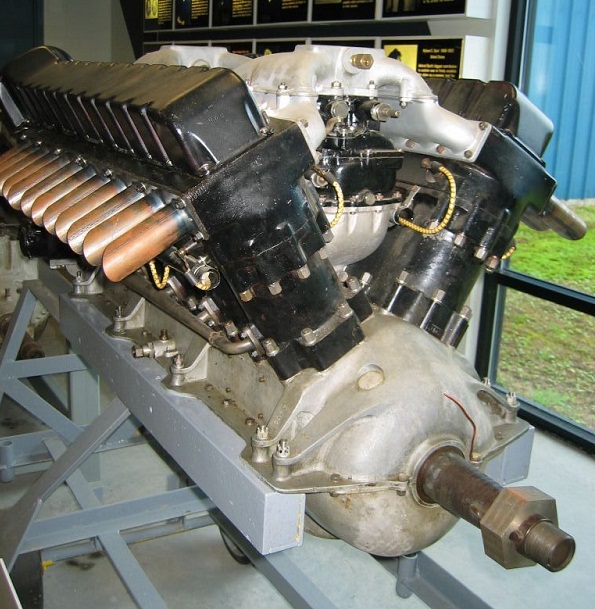| Curtiss D-12 |

| ||
|---|---|---|---|
| |
| ||
 |
|||
| The Curtiss D-12, designed by Arthur Nutt, was considered America's best water-cooled engine from 1921 to 1928. It was the first engine ever to power a plane to 200 mph. The D-12 was developed from the Curtiss K-12 engine used during World War I. In 1922, two US Army R-6 Racers powered by D-12s won the Pulitzer Trophy with an average speed of 205 mph. The R-6 longed-winged XPW-8 became the prototype for the PW-8 fighter. The D-12 won two Schneider Cups and was still a threat at the National Air Races up to the mid 1930s.1 | |||
| The D-12 was a 443 hp (330 kW) 12-cylinder Vee, liquid-cooled engine with seven main bearings using separate cast blocks for the cylinders and crankcase. The lubrication system drew oil from a separate oil reservoir through an oil cooler, otherwise know as a dry-sump system. The cylinders used wet-sleeves which allowed water to contact almost the entire length of the cylinder. This was a development of the Curtiss AB, later to become the K-12 engine. It used an old-style closed end cylinder sleeve. There were four valves per cylinder which were seated directly into the head. There were no valve seat inserts in the head. The valves were operated by two camshafts, one for the exhaust and one for the intake valves. This allowed all of the exhaust valves to be located on the outside of the cylinder to 12 separate stacks, one for each exhaust port. The engine had a dual ignition system using Splitdorf SS-12 magnetos.2 Both spark plugs were located on the inside of the Vee to prevent fouling. Stromberg NA-Y5 carburetors became standard for all D-12 engines.3 | |||
 |
|||
|
The D-12 replaced the propeller reduction gears with a more reliable direct-drive connection and resulted in the designation "D" for direct-drive. The engine was matched with a new propeller designed by Dr. S.A. Reed. It was a high speed aluminum propeller that allowed the engine to use its full power. This combination, along with the Stromberg carburetors, increased the engine to 2,500 rpm and allowed the Curtiss R-6 to achieve 244.9 mph in 1923.
In 1923, a Curtiss PW-8 powered by a D-12 broke the dawn-to-dusk continental crossing record by covering the USA in 21 hours and 48 minutes. The flight began from Mitchel Field, Long island at 3:00 a.m. EST and finished in San Francisco 9:48 p.m. Pacific Time. Allowing for refueling stops in along the 2,645 mile route, the actual flying time was 10 hours, 20 minutes. The D-12 was a lighter and smaller than the other two other 400 hp class engines at the time, the Rolls Royce Eagle and the Napier Lion. It was so advanced that in 1924, the Fairey Aviation Company Limited took out a license to produce the D-12. They designed a light bomber around the D-12 engine called the Fairey Fox which was a very advanced plane for the time and subsequently purchased by the RAF.4 After 1925 the Curtiss Company stopped development on the D-12 after achieving a virtual monopoly on fighter power plants. The D-12 was used on the Curtiss Falcon observation plane which replaced the De Havilland D.H. 4 and served well into the 1930s. It was a durable and reliable engine and powered all of the US Army's fighters until the emergence of the lighter and simpler air-cooled Pratt & Whitney Wasp in 1925. The D-12 was enlarged to the V-1400 and then eventually to the V-1570 which became known as the Curtiss Conqueror. | |||
| Specifications: | |
|---|---|
| Curtiss D-12 | Date: | 1922 |
| Cylinders: | 12 |
| Configuration: | Vee, liquid-cooled |
| Horsepower: | 443 (330 kw) |
| RPM: | 2,250 |
| Bore and Stroke: | 4.5 in. (112 mm) x 6 in. (152 mm) |
| Displacement: | 1,145 cu. in. (18.8 liters) |
| Weight: | 704 lbs. (320 kg) |
Endnotes:
|
1. Murray Rubenstein & Richard M. Goldman. To Join with Eagles. A complete illustrated history of Curtiss Wright aircraft from 1903 to 1965. Garden City, New York: Doubleday & Company, Inc. 1974. 70. 2. Hugo T. Byttebier. The Curtiss D-12 Aero Engine. Washington: Smithsonian Institution Press, 1972. 59. 3. Howard Mingos. Aircraft Year Book 1925. New York: Aeronautical Chamber of Commerce of America, Inc., 1925. 209. 4. Herschel Smith. A History of Aircraft Piston Engines. Manhattan, Kansas: Sunflower University Press, 1993. 71. |
© Larry Dwyer. The Aviation History On-Line Museum. All rights reserved.
Created March 3, 2013. Updated October 12, 2013.